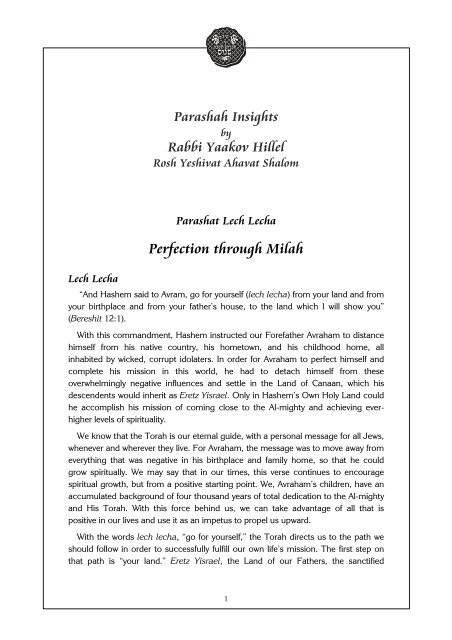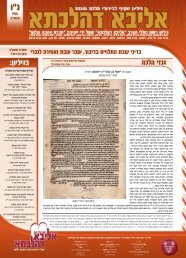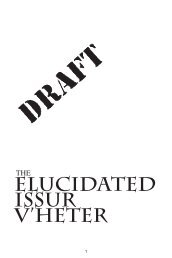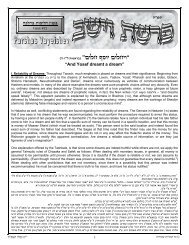Parashat lech lecha.pdf - Ner Gavriel
Parashat lech lecha.pdf - Ner Gavriel
Parashat lech lecha.pdf - Ner Gavriel
You also want an ePaper? Increase the reach of your titles
YUMPU automatically turns print PDFs into web optimized ePapers that Google loves.
Parashah InsightsbyRabbi Yaakov HillelRosh Yeshivat Ahavat ShalomLech Lecha<strong>Parashat</strong> Lech LechaPerfection through Milah“And Hashem said to Avram, go for yourself (<strong>lech</strong> <strong>lech</strong>a) from your land and fromyour birthplace and from your father’s house, to the land which I will show you”(Bereshit 12:1).With this commandment, Hashem instructed our Forefather Avraham to distancehimself from his native country, his hometown, and his childhood home, allinhabited by wicked, corrupt idolaters. In order for Avraham to perfect himself andcomplete his mission in this world, he had to detach himself from theseoverwhelmingly negative influences and settle in the Land of Canaan, which hisdescendents would inherit as Eretz Yisrael. Only in Hashem’s Own Holy Land couldhe accomplish his mission of coming close to the Al-mighty and achieving everhigherlevels of spirituality.We know that the Torah is our eternal guide, with a personal message for all Jews,whenever and wherever they live. For Avraham, the message was to move away fromeverything that was negative in his birthplace and family home, so that he couldgrow spiritually. We may say that in our times, this verse continues to encouragespiritual growth, but from a positive starting point. We, Avraham’s children, have anaccumulated background of four thousand years of total dedication to the Al-mightyand His Torah. With this force behind us, we can take advantage of all that ispositive in our lives and use it as an impetus to propel us upward.With the words <strong>lech</strong> <strong>lech</strong>a, “go for yourself,” the Torah directs us to the path weshould follow in order to successfully fulfill our own life’s mission. The first step onthat path is “your land.” Eretz Yisrael, the Land of our Fathers, the sanctified1
homeland given to us by the Al-mighty, is on a higher spiritual plane than any otherlocation on earth. Living there is especially conducive to spiritual growth.“From your birthplace” is a reference to the concept of community, themagnificent structure of heritage and tradition passed on from generation togeneration. “From your father’s house” refers to the education we receive from ourparents, as expressed in the verse, “Hear, my child, your father’s rebuke and do notforsake your mother’s Torah” (Mishle 1:8). The positive training and values weabsorb at home should continue to accompany us as we grow and developthroughout our lives.By following this path, we will succeed in reaching “the land (eretz) which I willshow you.” Our Sages use the term eretz as an allusion to the World to Come: “Allof Israel have a share in the World to Come, as it says (Yeshayahu 60:21), “And Yournation, all of them are righteous, they will inherit the land (eretz) forever’” (Sanhedrin100a).We should learn to utilize the assets of homeland, community, and family as toolsto help us reach the World to Come. In the words of the Ramhal, “Man was creatednot for his position in this world, but for his position in the World to Come.However, his situation in this world is the cause of his situation in the World toCome, which is the ultimate objective” (Mesillat Yesharim, Chapter 1). The path wetread in this world leads directly to our eventual reward in the World to Come.Perfect NumbersThe words <strong>lech</strong> <strong>lech</strong>a were used to tell Avraham to separate himself from the evilaround him in order to achieve perfection. These same words encourage us to turnour many blessings into steppingstones to perfection. Lech and <strong>lech</strong>a each have thenumerical equivalent of fifty, together totaling one hundred, a number signifyingperfection. 1We find an allusion to this concept in our Sages’ description of the various stagesof man’s life, and his growth in Torah and the service of Hashem. They start with “Afive-year-old begins Scripture,” tracing his development over the years, and concludewith “a hundred-year-old is as if he is dead and gone from the world” (Avot 5:21). Bythe age of one hundred, man achieves such a lofty level of spiritual perfection that1In other languages, the alphabet and numbers are separate and unrelated: A,B,C is distinct from1,2,3. Hebrew is unique in that it has no numbers; the letters also serve as numbers. Alef, the firstletter, is one, bet, the second letter, is two, continuing up to yud, ten. Numbers higher than tenare expressed by a yud with an alef (eleven), yud-bet (twelve), etc. In addition to the meaning ofany given word expressed by the characters read as letters, it also has a numerical equivalent(gematriya) composed of the value of its letters in numbers.2
he is on a higher plane, as if he is no longer in the physical world. While it is possibleto live longer than one hundred years, our Sages did not go any further, becauseone hundred indicates perfection.One hundred is composed of ten times ten. To better appreciate the significanceof the number one hundred, let us first understand something about the significanceof the number ten.Our Sages teach that Hashem created the world with ten Utterances, calledMaamarot. (Avot 5:1). The Mekubalim explain that these Utterances are ten specificrevelations of ways that Hashem relates to His created beings, in accordance withtheir deeds. The Sefer Yetzirah calls them ten Sefirot, ten spiritual forces throughwhich Hashem rules the world, each a different level of connection to Him. Everyone of the ten Sefirot, a perfect entity unto itself, is divided into ten sub-categories.Hashem is the essence of perfection, and what He creates is perfection. Hischoice of specifically ten Sefirot, each subdivided into ten, as the instrument ofCreation and revelation teaches us that ten is perfection, while ten times ten isabsolute perfection.Interestingly, we find the concept of ten as perfection in the decimal system, theuniversal basis of mathematics. In this system, the highest numeral is nine. Tencompletes the cycle, with any number after nine represented by a one with theaddition of another digit. For example, one with a zero is ten, one with another one iseleven, and so on. All the numbers link up to ten, which is higher, all-encompassingperfection.The Torah tells us that man was created in the image of G-d: “And G-d createdman in His image, in the image of G-d He created him” (Bereshit 1:27). It is one ofthe Thirteen Principles of Faith that the Al-mighty has no physical image or form atall (Rambam, Perush Hamishnayot, Sanhedrin, Perek Helek). Our Sages explainthis extremely profound statement on many levels. One explanation is that as wesaid, perfect revelation of the Al-mighty is through the ten Sefirot. Man, created in G-d’s image, so to speak, also contains these same ten spiritual forces, symbolized inhis physical form.The Mekubalim teach that man’s body has ten primary parts, corresponding tothe ten Sefirot. Man’s skull is Keter (the Crown). It is the repository of the threecompartments of the mind: Hochmah in the right brain, Binah in the left brain, andDaat in the brain at the nape of the neck. 2 The right arm represents Hesed2Hochmah, wisdom, is the capacity to accumulate and store knowledge. Binah, intelligence, isthe capacity for intellectual depth. Daat, reason, is the capacity for practical application of ourknowledge.3
(Lovingkindness) and the left arm represents Gevurah (Might), as we find in ourSages’ teaching, “the left hand should always push away (Might) and the right hand[should always] draw close (Lovingkindness)” (Sotah 47a). The torso is Tiferet (Glory– Truth). The two legs which support the body correspond to Netzach (Infinity) andHod (Splendor). The brit kodesh, man’s organ of procreation, is Yesod (Foundation)and the atarah, its crown, is Malchut (Kingship). 3The hundred-year-old who is no longer of this world has rectified all of these tenlevels and the sub-categories they encompass; we may say that he is one hundredpercent perfect. The words <strong>lech</strong> <strong>lech</strong>a – two fifties totaling one hundred – allude tothis striving for spiritual perfection, which should be our life’s goal.The Al-mighty commanded Avraham, “Walk before Me and be perfect” (Bereshit17:1). Our Sages teach us that “perfect” refers to the commandment ofcircumcision (Rashi citing Bereshit Rabbah 46:1). Throughout his life, Avrahamworked to purify himself from head to foot, rectifying each of the ten levelscorresponding to the Sefirot. In his first ten years he rectified the ten levels includedin the Divine Attribute of Keter. In the next ten years he rectified Hochmah, thenBinah, and so on. Finally, aged ninety-nine years, he reached the ninety-ninth level,the last stage before complete perfection. By removing the orlah (foreskin) andrevealing the atarah, he reached the perfection of the hundredth level, in hishundredth year. Lech <strong>lech</strong>a, one hundred, alludes to the spiritual perfection of thishighest level, when Avraham was finally ready to become part of the Divine Chariot.Now he could “walk before G-d and be perfect.”There is another lesson we can learn from the division of the perfect hundred intofifty and fifty. Fifty implies half. The years which comprise the first half of a person’slife are his primary time for growth and development. The second half are years ofdecline, as his strength gradually wanes. This is known as “fifty days of ascent andfifty days of descent” (Rema, Torat HaOlah, vol. II, Chapter 12) They tell us that“One who learned Torah in his youth should [continue] learning Torah in his oldage, and one who taught students in his youth should [continue to] teach studentsin his old age” (Yevamot 62b). Both periods should be utilized to the maximum. Weshould not waste the growing years, assuming that we will have plenty of time toserve Hashem when we are old. We should also use the later years to the fullest,rather than saying that we are too weak and tired to go any further. At every stage inlife, we must serve Hashem to the best of our abilities, working to achieve a perfectone hundred in avodat Hashem.A Portent for the Sons3See second Introduction to Tikune Zohar, Patah Eliyahu, and my work Shorshe HaYam,Helek Alef, for a fuller explanation of this topic.4
Our Sages tell us that our Forefather Avraham fulfilled the entire Torah beforebeing commanded, including even rabbinically ordained commandments like eruvetavshilin (Yoma 28b). 4 This is because the Forefathers knew through propheticinsight which deeds would bring rectification to their souls and to the world (OhrHaHayyim on Bamidbar 12:12; Maharal, Gur Aryeh, Bereshit 56:10; NefeshHaHayyim, Shaar Alef, Chapter 21). This raises an obvious question. If Avrahamfulfilled all the mitzvot on his own, why did he not fulfill the important mitzvah ofcircumcision until he was explicitly commanded by Hashem? In addition, why didHashem wait until Avraham reached the advanced age of ninety-nine, and only thencommand him to circumcise himself?We can answer these questions by considering the unique nature of Avraham’sservice of Hashem.Our Sages teach us that “the deeds of the fathers are a portent for the sons”(Ramban on Bereshit 12:6, citing the Sages). This means that the enormous effortsour Forefathers invested in serving Hashem pay eternal dividends for theirdescendents. Their initial labor and toil made a permanent impression, so thatspiritual accomplishments which they had to struggle to achieve can now beacquired more easily by subsequent generations. Children inherit their parents’spiritual strengths; we are “midgets resting on the shoulders of giants” (Torat Moshe,Bamidbar 12:3; see Eduyot 2:9). This is how “the deeds of the fathers are a portentfor the sons.”Avraham was the first Jew to fulfill the commandment of circumcision. He neededninety-nine years of dedicated avodat Hashem to ready himself for the sacredcovenant of milah. Avraham passed on his hard-won spiritual gains to his children.Thanks to all that he put into this crucial mitzvah, his descendents can becircumcised at the age of eight days.Let us try to understand more about this profound concept. Our Sages tell us thatAvraham lacked only a cut on the flesh to complete his circumcision, because hisorlah had already been crushed by marital relations (cited in Rashi, Bereshit 17:25)Clearly, our Sages are not suggesting that Avraham was steeped in desire to thepoint where he was physically damaged by excess. They are telling us somethingmuch more profound about Avraham’s spiritual stature.The orlah is symbolic of evil and the Forces of Impurity which have a grip on man.Cutting off the foreskin has the effect of annulling this evil. Avraham was notcircumcised until the age of ninety-nine, but by subduing and “crushing” his desiresthrough engaging in marital relations in sanctity and purity, solely for the sake ofHeaven, he succeeded in eliminating the impurity of the orlah by his own efforts.4A rabbinical ordinance allowing for preparation of food for Shabbat on a Festival which falls onFriday.5
We see here how the deeds of the fathers are a portent for the sons. Avraham hadno “forefathers” whose merits and accomplishments would support him; he wasstrictly on his own. This is why he could not remove the evil forces merely by meansof the physical act of circumcision until he had first removed them by his spirituallabors, an enormous accomplishment. After he refined himself to this extremely highlevel, Hashem told him, “walk before Me and be perfect” – Avraham was finally ableto fulfill the commandment of circumcision.Avraham’s circumcision at ninety-nine was the culmination of a lifetime of hardwork, and his exertions imbued his descendents’ circumcisions with the power of hisown toil. We, the Jewish people, received milah at eight days, without the need for alifetime of prior purification, as a gift from our saintly Forefather.Perfection through CircumcisionWe can understand the words “walk before Me and be perfect” in another sense aswell. Before circumcision, man is connected to the Forces of Impurity that reside (inan esoteric sense) “at the back.” Once circumcised, he is bound to holiness and theForces of Purity which reside “in front.” Then he can walk before the Al-mighty,perfecting himself through Torah, mitzvot, and refined middot.We find this idea in Birkat HaAretz, the second blessing in the Grace after Meals.We thank Hashem “for Your covenant (brit) that You sealed in our flesh, and forYour Torah that You taught us.” The latter is dependent on the former: only one whois circumcised can understand Torah and achieve perfection in the fulfillment of itscommandments.Our Sages describe Avraham’s circumcision with an interesting parable. A kingasked a noblewoman who had been suggested as his bride to walk in front of him sothat he could study her appearance. The lady obeyed, but she was unhappy with thisrequest, fearing that the king would find something about her that was not to hisliking. The king reassured her, telling her that he saw no flaws at all, other than a tinytoenail that was a bit too long. Once that nail was cut off, he told her, she would beabsolutely perfect. The same was true of Avraham: he stood before the Al-mightyand was nearly perfect. Once his orlah was physically removed, he would be free ofany flaw whatsoever (Bereshit Rabbah 46:4).A teaching of the Arizal helps us understand why the Sages compared the orlah toa toenail (Etz Hayyim, Shaar Lamed-alef, Chapter 2). He writes that the Forces ofImpurity are attached to the place where the toenail protrudes from the flesh. It isfrom this impure place that they derive their powers. (We also find this comparisonin our Sages’ euphemistic expression (Niddah 66a), “not all fingers are equal”). Thesame is true of the orlah. It is no more than a scrap of useless extra skin, to whichthe evil forces attach themselves.6
Yitzhak and YishmaelOur Sages recount a major debate between Avraham’s two sons, Yitzhak andYishmael. “Yitzhak and Yishmael were arguing. The latter said, ‘I am more belovedthan you because I was circumcised at the age of thirteen years.’ The former said, ‘Iam more beloved than you because I was circumcised at the age of eight days.’Yishmael said to [Yitzhak], ‘I am more beloved than you. Why? Because I wascapable of protesting, and I did not protest.’ At that moment, Yitzhak said, ‘If onlythe Holy One, blessed be He, would reveal Himself to me and tell me to cut off oneof my limbs, and I would not refuse. Immediately afterward, ‘And Hashem testedAvraham’ [with Akedat Yitzhak, where Yitzhak was called upon to give up his very lifefor Hashem]” (Bereshit Rabbah 55:4). 5Why did Yitzhak maintain that his circumcision at eight days made him morebeloved? Viewed logically, Yishmael’s claim does seem to make a great deal ofsense. As a mature adolescent in full possession of his faculties, he was perfectlycapable of refusing to submit to circumcision, and yet, he agreed. Yitzhak, a helplessnewborn, had no input in the decision to be circumcised, and the pain he sufferedwas certainly much less as well.And yet, Yitzhak’s circumcision – and that of every eight-day-old baby since –bears an element of paramount importance which was lacking in Yishamel’s.Circumcision at eight days fulfills the fundamental principle of naaseh v’nishma(Shmot 24:7). These words, literally translated as “we will do and we will hear,” mean“first we will fulfill, and then we will understand what we are fulfilling.” They are thefoundation of our people’s acceptance of the Torah. The non-Jewish nations refusedto consider taking on the Torah without first hearing exactly what it would demand ofthem, and then deciding if they were ready to meet those demands (see Sifri, V’ZotHaBerachah 343). In contrast, naaseh v’nishma is an impulsive expression ofimplicit faith and trust in Hashem’s Word. It means that we accept and obey His Willentirely, regardless of whether or not we recognize the logic behind it. Circumcisionat eight days instills this highest level of obedience to the Al-mighty in our childrenfrom infancy. This, Yitzhak said, is most beloved to G-d. Yishmael was prepared tosacrifice a scrap of skin that served no purpose. Yitzhak was not only willing but eveneager to give up his entire being out of love and dedication to Hashem.Milah and the MitzvotMan’s ultimate purpose is to rectify and perfect himself by fulfilling the six hundredand thirteen commandments. The body’s ten main parts consist of two hundred andforty-eight limbs and three hundred and sixty-five sinews, corresponding respectivelyto the positive and negative commandments, a total of six hundred and thirteen.5See Shavuot Insights for a fuller discussion of this topic.7
Fulfillment of all the commandments brings spiritual perfection to every aspect ofthe human body.The word brit (literally “covenant,” a reference to brit milah, the covenant ofcircumcision) has the numerical equivalent of six hundred and twelve, because britmilah is the prerequisite for all the other six hundred and twelve commandments(Nedarim 31b). All mitzvot and good middot have their root in circumcision.Mitzvot are related to man’s G-dly soul, and middot to his base soul (see ShaareKedushah, Shaar Alef). The uncircumcised individual can neither fulfill mitzvotproperly nor refine his middot, because the orlah serves as a barrier between himand holiness. Removing it opens the door to spiritual growth. This is whycircumcision is the first mitzvah in a child’s life, performed just a few days after birth.Mitzvot are divided into three categories, which correspond to the three stages ofthe process of halachic circumcision. We have the negative commandments, explicitprohibitions which we must avoid at all costs, such as idol worship and theconsumption of non-kosher food. We also have the positive commandments, ourobligations as Jews, such as tefillin and shofar. Then we have the gray area ofdiscretionary activities (reshut), a domain which is not clearly defined, but isnonetheless a critical testing ground of our commitment to Hashem and His Torah.The Torah tells us, kedoshim tihiyu: you will be holy (Vayikra 19:2). The Rambanexplains that this commandment refers to reshut, the vast range of permissibleactivities which are not mitzvot, but which nevertheless make up a considerable partof our lives. For example, the Torah allows us to marry, engage in business,consume meat and wine, and the like. And yet, if we spend our days indulging in thepleasures of marriage, money, and mealtimes, we are what the Ramban calls “adegenerate within the permitted bounds of the Torah,” or in other words, a monsterwith a hechsher. Are we doing anything which is outright forbidden? If we are carefulabout the details, then no, not really. But G-d did not put us in this world solely forcoffee, cake, and the stock market. If we relate to the mundane aspects of our livesas part of our service of Hashem, we make them – and ourselves – holy. If we plungein headfirst for the permissible pleasures they bring, we will be anything but.The mitzvah of milah consists of three stages, corresponding to these threecategories.The first stage is cutting off the foreskin. As we explained, evil and the Forces ofImpurity attach themselves to the orlah. By removing it, we separate the Forces ofEvil from the newborn. The orlah is called the “portion of the snake,” symbolic ofevil. This is why we cover it with dust after it is cut off, burying it completely. We findan allusion to this concept in the verse “And the snake, its bread is dust” (Yeshayahu65:25).8
Cutting off the orlah corresponds to the three hundred and sixty-five negativecommandments; we must sever all contact with everything the Torah forbids, in thesame way that we cut off the orlah altogether.The second part is periah, uncovering the atarah at circumcision by splitting thefine inner layer of skin and pushing it inward toward the body, symbolically directingit to holiness. 6 Periah corresponds to the Torah’s commandment to be holy, or thegray area of reshut.Life abounds with discretionary activities. They are not forbidden, and they can goeither way, to good or to bad; it all depends on how we relate to them. The same istrue of the inner skin which we peel away in periah. It can be pushed inward asrequired by halachah, revealing the atarah, symbolic of sanctity, or it can be allowedto fall back and cover the atarah. This is how we should deal with activities which arereshut. Confined to their proper place, they can become part of our service ofHashem. Allowed to grow unchecked, they obscure the element of sanctity.The mitzvah of periah is also symbolic of the need to control and refine ourmiddot. Carefully directed, any character trait can become an asset in servingHashem. Left unchecked, our middot will ultimately run wild and destroy ourspirituality.The third stage of milah is revelation of the atarah, which is the symbol ofsanctity. This stage of milah corresponds to the fulfillment of the positivecommandments.Now we can understand Yitzhak’s words, “I am more beloved than you, because Iwas circumcised at eight days.” True, Yishmael’s circumcision had the element ofwilling choice. However, circumcision at eight days is of greater importance,because it separates man from evil from his very earliest days, opening him up tosanctity almost from birth. Milah at its proper time – the tender age of eight days – isthe first step on the path of Torah. It is a declaration of naaseh v’nishma.For thousands of years, our people have circumcised their sons at the age of eightdays, with all that this cherished mitzvah implies. There can be nothing greater andmore beloved than this continual renewal of our eternal bond to the Al-mighty.“And Your nation, all of them are tzaddikim, they will inherit the land forever”(Yeshayahu 60:21). Our Sages teach that a tzaddik is one who upholds the sanctityof brit milah (Zohar, <strong>Parashat</strong> Lech Lecha , p. 94a, et al). In the merit of ourdevotion to the mitzvah of milah we will “inherit the land forever,” earning life in thisworld and in the World to Come.6The Arizal teaches that periah must be done as a separate step following the cutting of theorlah, rather than cutting off both layers of skin together (Shaar HaMitzvot, Lech Lecha 9a, citedin my work Ateret Shalom, Ot Chaf).9
















